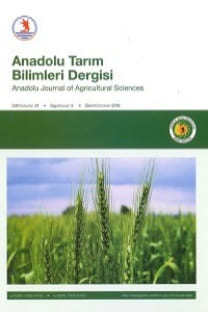Dactylorhiza romana (sebast.) soo. salep orkidelerinde dört yıllık gelişim sürecinin tanımlanması
Description of development period of Dactylorhiza romana (Sebast.) Soo. during four consecutive years
Annual development, Flower, Orchids Sahlep, Tuber,
___
- Arditti, J., 1967. Factor affecting the germination of orchid seeds. Botanical Review, 33: 1-97. https://doi.org/10.1007/BF02858656
- Arditti, J., Ghani, A.K., 2000. Numerical and physical properties of orchid seeds and their biyological implications. New Phytologist, 145: 367-421. https://doi.org/10.1046/j.1469-8137.2000.00587.x
- Baskın, C.C., Baskın, J.M., 1998. Seeds. Ecology, biogeography, and evolution of dormancy and germination. Academic Press, XIV. San Diego, 666 s.
- Baytop, T., 1994. Türkiye Bitki Adları Sözlüğü. Atatürk Kültür Dil ve Tarih Kurumu Yayın No: 578. Ankara, 512 s.
- Baytop, T., 1999. Türkiye’de Bitkilerle Tedavi; Geçmişte ve Bugün. Nobel Tıp Kitabevleri. İstanbul, 480 s.
- Bektaş, E., Cüce, M., Sökmen, A., 2013. In vitro germination, protocorm formation, and plantlet development of Orchis coriophora (Orchidaceae), a naturally growing orchid species in Turkey. Turkish Journal of Botany, 37: 336-342. doi:10.3906/bot1205-28
- Blinova, I.V., Uotila, P., 2012. Dactylorhiza traunsteineri (Orchidaceae) in murmanks region (Russia). Memoranda Societatis pro Fauna et Flora Fennica, 88: 67-79. https://journal.fi/msff/article/view/7819
- Çalışkan, Ö., 2018. Salep Orkideleri. Erol Ofset. Samsun, 105 s.
- Çağlayan, K., Özavcı, A., Eskalen, A., 1998. Doğu Akdeniz bölgesinde yaygın olarak yetişen bazı salep orkidelerinin embriyo kültürü kullanılarak in vitro koşullarda çoğaltılmaları. Turkish Journal of Agriculture and Forestry, 22: 187-191.
- Çığ, A., Demirer Durak, E., İşler, S., 2018. In vitro symbiotic germination potentials of some Anacamptis, Dactylorhiza, Orchis and Ophrys terrestrial orchid species. Applied Ecology and Environmental Research, 16(4): 5141-5155. 10.15666/aeer/1604_51415155
- Daşkın, R., Yılmaz, Ö., Kaynak, G., 2007. A new record for the flora of Turkey: Dactylorhiza maculata (L.) Soó (Orchidaceae). Journal of Biological and Environmental Sciences, 1(1): 11- 14.
- Ernaz, E.A., Sevgi, E., Kara, Ö., Sevgi, O., Tecimen, H.B., Bolat, İ., 2012. Comparative morphological, anatomical and habitat studies on Dactylorhiza romana (Seb.) Soó subsp. romana and Dactylorhiza romana (seb.) Soó subsp. georgica (Klinge) Soó ex Renz & Taub. (Orchidaceae) in Turkey. Pakistan Journal of Botany, 44: 143-152.
- Gorbani, A., Gravendeel, B., Zarre, S., Boer, H., 2014. Illegal wild collection and international trade of cites listed terretrial orchid tubers in Iran. Traffic Bulletin, 26(2): 53-58.
- Hossain, M.M., 2011. Therapeutic orchids: traditional uses and recent advances-An overview. Fitoterapia, 82: 102-140. https://doi.org/ 10.1016/j.fitote.2010.09.007
- Farhoosh, R., Riazi, A., 2007. A compositional study on two currents types of salep in Iran and their reolojical properties as a function of concentration and temperature. Food Hydrocolloids, 21: 660-666. https://doi.org/10.1016/j.foodhyd.2006.07.021
- Jacobsone, G., 2008. Morphogenesis of wild orchid Dactylorhiza fuchsii in tissue culture. Acta Universitatis Latviensis, 745(Biology): 17-23.
- Isin, M.P., 2008. Salep, spiced winter drink and cure-all (salep, rahat-ı can sıhhatü’l-ebdan talim-i nefayis). I. Uluslararası Tıp Tarihi Kongresi ve 10. Ulusal Tıp Tarihi Kongresi (20-24 Mayıs 2008, Konya) Bildirileri, 382-395.
- Kasparek, M., Grim, U., 1999. Europen trade in Turkish salep with special reference to Germany. Economic Botany, 53(4): 396-406. https://doi.org/10.1007/BF02866718
- Mehra, S., 2014. Nutritional and genetic diversity in orchid mycorrhizal fungi from Caladenia species. Doktora Tezi, RMIT University School of Applied Sciences, College of Science Engineering and Health, 436 s, Melbourne.
- Özkoç, İ., 1991. Serapias vomeracea (Burm.fil.) briq.subsp laxiflora (Soo) Gölz et. Reinhard ve Orchis laxiflora lam. (Orchidaceae) tohumlarının simbiyotik ve asimbiyotik kültürlerde çimlenme ve gelişmesi üzerinde araştırmalar. Doktora tezi, Ondokuz Mayıs Üniversitesi Fen Bilimleri Enstitüsü, 77 s, Samsun.
- Rasmussen, H.N., 1995. Terrestrial orchids: from seed to mycotrophic plant. Cambridge University Press, 444 s, Cambridge.
- Renz, J., Taubenheim, G., 1984. Orchis L. (Orchidaceae), in: (Ed.): P.H. Davis, Flora of Turkey and the East Aegean Islands. Edinburgh University Press, 8:451-600, Edinburgh.
- Sezik, E., 1984. Orkidelerimiz. Sandoz Kültür Yayınları No:6, 166 s, İstanbul.
- Sezik, E., 2002. Turkish orchids and salep. Acta Pharmaceutica Tursica, 44: 151-157.
- Sezik, E., İşler, S., Güler, N., Orhan, Ç., Aybeke, M., Deniz, İ.G., Üstün, O., 2007. Salep ve orkidelerin tahribi. Tübitak, TBAG-Ç.SEK/23 (103T008) no’lu proje sonuç raporu, Ankara.
- Shipunov, A.B., Fay, M.F., Pillon, Y., Bateman, R.M., Chase, W., 2004. Dactylorhiza (Orchidaceae) in European, Russia: combinet moleculer and morphological analysis. American Journal of Botany, 91(9): 1419-1426. https://doi.org/10.3732/ajb.91.9.1419
- Tutar, M., Parlak, S., Sarı, A.O., Çiçek. F. 2013. Salep orkidelerinde tohumdan üretimi. XI. Ulusal Ekoloji ve Çevre Kongresi (1-4 Ekim 2013, Samsun) Bildirileri, 241-249.
- Warghat, A.R., Bajpai, P.K., Srivastava, R.B., Chaurasia, P., Chauhan, R.S., Sood, H., 2014. In vitro protocorm development and mass multiplication of an endangered orchid, Dactylorhiza hatagirea. Turkish Journal of Botany, 38: 737-746. https://dx.doi.org/10.3906/bot-1308-48
- ISSN: 1308-8750
- Yayın Aralığı: 3
- Başlangıç: 1986
- Yayıncı: Ondokuz Mayıs Üniv. Ziraat Fak.
Dactylorhiza romana (sebast.) soo. salep orkidelerinde dört yıllık gelişim sürecinin tanımlanması
Kübra Meriç KALIN, Mehmet Arif BEYHAN
Kübra DELİSOY, Hacer Handan ALTINOK
İsmail ERPER, Rahman KUSHIYEV, Elif YILDIRIM, Muharrem TURKKAN, Celal TUNCER
Pirina ve balık atıklarının birlikte kompostlanması ve toprak ıslahında kullanılması
Remzi İLAY, Gökhan ERARSLAN, Yasemin KAVDIR
Şeyma SARIBAŞ, Ahmet BALKAYA, Dilek KANDEMİR, Onur KARAAĞAÇ
Farklı kökenli arpa çeşitlerinin tane verimi ve bazı kalite özellikleri yönünden değerlendirilmesi
